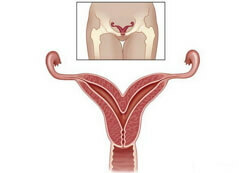Menopause
 Menopause is one of the climacteric phases associated with the complete completion of the hormonal function of the ovaries. The term "menopause" involves a lot of myths and inaccuracies, meanwhile, this important age stage will sooner or later be experienced by each of the women. As a rule, the more correct, reliable, knowledge about menopause has a woman, the more adequately she relates to what is happening and the easier it is to adapt to it. And, on the contrary, the more "terrible" information it receives from incorrect sources, the more difficult it is to take what is happening properly. It is definitely established that the psychological state of women entering menopause largely determines the course of this period.
Menopause is one of the climacteric phases associated with the complete completion of the hormonal function of the ovaries. The term "menopause" involves a lot of myths and inaccuracies, meanwhile, this important age stage will sooner or later be experienced by each of the women. As a rule, the more correct, reliable, knowledge about menopause has a woman, the more adequately she relates to what is happening and the easier it is to adapt to it. And, on the contrary, the more "terrible" information it receives from incorrect sources, the more difficult it is to take what is happening properly. It is definitely established that the psychological state of women entering menopause largely determines the course of this period.
First of all, it is necessary to clearly define the term "climax".More often, women identify him with menopause, climacteric syndrome or even old age. In fact, nothing has to do with illness or aging menopause. Like any other age-related life stage, menopause is a natural physiological period when the natural extinction of the reproductive function and the completion of hormonal activity of the ovaries occur. In fact, in the climacteric period there are two major events - the cessation of the ovaries and the adaptation of the whole organism to this state. These changes take place gradually and take a lot of time. The first single clinical symptoms of menopause start at 45 years old, and for its termination the age of 65 is conventionally accepted. This framework only limits the permissible limits within which changes can be taken as natural.
The climacteric period, according to the functional and structural changes in the ovaries, is classified into several important stages, or phases.
The time from the appearance of the first signs of ovarian dysfunction to the last independent menstruation is defined as a premenopause. It is distinguished by the presence of monthly, which become unusually abundant and irregular.
Then follows the period of menopause. In fact, it is the last monthly. However, since by this time menstruation is already irregular and late, it is problematic to determine the latter. Therefore, the last menstruation during the menopause is set retrospectively: after 12 months of absence of the following. Thus, menopause is spoken within a year after the end of menstrual function. Some experts believe that this period may be longer - up to six months or even 2 years.
Pregnancy during menopause, due to the completion of the ovaries, is impossible. However, in premenopause, when single ovulatory cycles, after all, happen, it is hypothetically probable. Most often, the menopause of the patient is incorrectly called a climax, and confusion arises.
Following the menopause, the menopause period is postmenopause. It is characterized by complete extinction of the hormonal function of the ovaries and the absence of menstruation, respectively.
Premenopause and menopause time( the last months and a year after them) are often combined into perimenopause, as they have a common symptomatology.
The time frames of climacterium periods are very conditional, but they clearly reflect morpho-functional changes in the reproductive system.
Menopause may be early when premenopausal symptoms appear before the age of 40 years. About the late climacteric period speak, if he starts after 55 years.
Clinically, menopause periods are the gradual extinction of menstrual function and the increasing extragenital symptoms associated with loss of estrogenic effects by the body.
The climacteric period is a normal age-related physiological process that can not be correlated with the disease. In addition to completing the reproductive function, it has no goals. It is not right to associate menopause with old age, after all, after a woman starts her, she remains attractive and vitally active for a long time, if only she has formed the right attitude to the changes taking place.
If menopause occurs with pathological symptoms, it is customary to talk about a climacteric syndrome, or a pathological climax that needs therapy.
What is the menopause
Menopause is the last independent menstruation, after which there are no menstruation for 12 months. It can be said that menopause is a kind of barrier separating two long and significant periods of menopause - pre- and postmenopause.
The onset of menopause indicates a definitive cessation of cyclic ovarian function. As a rule, in the majority it comes at the age of 50, but in quite healthy women this period may be somewhat shifted.
All causes of menopause are "hidden" in the cyclic function of the ovaries and the central structures that regulate it. Ovaries as a paired hormone gland begin to function fully in the period of the puberty finale( puberty), which starts more often at 11 to 13 years of age and is completed by 16 years. The hormonal function of the ovaries does not stop for many years and stops only in menopause.
Ovaries are responsible for the synthesis of estrogen( estradiol) and progesterone. The secretion of these hormones occurs pofazovo and is accompanied by certain cyclical changes both in the ovaries themselves and in other hormone-dependent organs. Estrogens are synthesized by follicles into the first, follicular phase. Follicles are present in the ovaries initially, that is, they are formed during the ripening period. Each such follicle in the future can reach the degree of necessary maturity and become a source of development of the oocyte.
Each month, several( 10-15) immature follicles begin to grow actively, and only the most "suitable", usually single, proliferating follicle passes through all the necessary stages of maturation and transforms into a primordial follicle - a small hormone that synthesizes estrogen. The primordial follicle is the place of maturation of the egg, providing it with protection and nutrition. When the egg cycle ends, the follicle breaks down( ovulation) and releases it, and in its place another hormonal structure is formed - the yellow body that synthesizes progesterone.
Thus, ovulation conditionally breaks the menstrual cycle into approximately equal in duration two phases. The first, the follicular phase, ends with ovulation, and the second - luteal, it begins. Such cyclic changes are repeated monthly and controlled by the central departments - the hypothalamus and the pituitary gland, which also function in a cyclic rhythm: in the first phase, the pituitary gland stimulates folliculogenesis with FSH, and the second it secrete LH.
In menopause, there are no maturing follicles in the ovaries, there are no estrogens( estradiol), and menopause does not come during menopause.
Hormonal function of the ovaries provides the ability to reproduce. For obvious reasons, the possibility of its implementation must have a certain age range, and the only way to abolish the possibility of childbirth is physiological female infertility, which is achieved only when the ovaries are "turned off".The climacteric period allows the female body to gradually adapt to the extinction of the hormonal ovarian function, and the menopause manifests its complete cessation. Therefore, pregnancy during menopause is unreal.
Symptoms and signs of menopause
Menopause is determined by a single reliable symptom - the termination of menstrual function. If a year has passed since the last menstrual period, and the next one has not come, you can talk about menopause. Any bloody discharge after menopause by menstruation is not and is classified as pathological bleeding. The exception is a small group of women whose menopause, for unexplained reasons, lasts a little longer - up to one and a half and even two years. Menstrual bleeding in them can resume after a year, while most of them no longer exist. To differentiate the bleeding that appears, an examination is assigned, and only in the absence of deviations, menopause in such patients is "postponed".In this situation, to say that the menstrual period has gone during menopause is not entirely correct.
Asymptomatic menopause does not happen. The clinical picture is affected by the severity of menopausal symptoms. If their number and intensity correlate with a woman's ability to live a familiar life with minimal discomfort, menopause is considered physiological.
As mentioned above, all symptoms of menopause are provoked by a deficiency of estrogens. It should be noted that estradiol is not the only estrogen hormone, but it has a significant effect on the state of so-called "target organs".Target organs have specific receptors for estrogens and depend on their cyclic action. When the ovaries stop "supplying" hormones to such structures, there is a pronounced dysfunction, the symptoms of which are included in the list of symptoms of menopause and menopause in particular.
There are classical( reproductive) target organs and extra-genital( non-reproductive) organs.
Reproductive targets: the genital tract, mammary glands and the central link of the regulatory chain - the hypothalamus and pituitary gland.
The non-target target organs are the brain, vascular / cardiac system, bone marrow structures, urinary tract, large intestine, skin and hair, liver.
Any of these structures in hypoestrogenic conditions reacts with dysfunction of varying degrees of severity, so the clinic of the menopausal period is so diverse and depends on several factors: the state of the woman's somatic and gynecological health, lifestyle, psychoemotional mood and hereditary factor.
After the termination of the hormonal function of the ovaries, the body does not completely lose estrogenic influence. The source of estrogen after menopause is adipose tissue and adrenal glands, but they synthesize only estriol and estrone, which can not be compared with estradiol ovaries in terms of the degree of influence on the body, but help maintain its adaptive ability.
Conditionally, all possible menopausal disorders by the time of maximum manifestation are divided into early, delayed and late.
Early symptoms appear already in the premenopausal phase and reach the highest severity in the first year after its arrival. More often such are:
- Vasomotor disorders: hot flushes, chills, increased sweating, headache, tachycardia, lability of blood pressure( fluctuations from hypo- to hypertension).Headaches during menopause are migraine.
"Visiting card" climacteric are considered hot flashes - a feeling of gradually rolling warmth / heat, more often to the upper part of the trunk, accompanied by intense sweating. The nature and severity of this symptom is ambiguous, but very accurately characterizes the body's ability to adapt to menopause. In the physiological course of this period, hot flushes appear more often in the morning or evening, are moderately expressed and do not cause serious suffering. Sometimes they happen only at night and are felt by a woman with night sweats, when she does not fix the beginning of the tide, but wakes up from sweating.
The number of tides per day is taken by specialists for the criterion of severity of the climacteric period. Less than ten tides daily correlate with a mild course of menopause, from 10 to 20 - with an average degree, and their number exceeding 20, indicates a pathological climacterium with severe course.
- Changes in the emotional sphere due to autonomic dysfunction: irritability, unmotivated anxiety, memory loss, absent-mindedness, drowsiness and the like. As a rule, it is the symptoms from this group that give the woman the greatest discomfort, as they greatly distort the habitual rhythm of life and prevent them from adapting to the ongoing changes in the body.
Despite the complex structural changes in organs and tissues, it is the emotional sphere that can seriously complicate the condition of women in menopause. Thoughts about the advancing "old age", loss of female attractiveness, inspired by pathological processes in the emotional sphere, can provoke depression.
Delayed climacteric manifestations start no later than three years after menopause. These include:
- Disorders of the urogenital sphere that result from atrophic changes in mucous membranes and subsequent inflammatory changes.
- Changes in the skin and its appendages: dry skin, brittle hair and nails, wrinkles.
Late manifestations of menopause accompany the postmenopausal period and relate to metabolic and cognitive disorders.
Pathological menopause is classified as a climacteric syndrome. It is characterized by the same symptoms of physiological menopause, but expressed in a more significant form. Independently the organism to compensate pathological menopause is not able, therefore it needs medicamental help.
Monthly after menopause
True menopause is the last menstruation. It is logical to assume that if after the menstruation comes the next, and then again and again, the organism is in premenopause, when the monthly, though confused, but still happen.
If the onset of last menstruation is established reliably, any spotting in menopause can not be menstrual, but indicates bleeding.
More often bleedings in the perimenopause phase are provoked by polyps formed in the endometrium, submucosal( submucous) myomatous nodes, adenomyosis. They also provoke pelvic pain in menopause.
Unfortunately, the list of causes of menopausal and postmenopausal bleeding is not limited only to benign changes, therefore, any similar to spotting after menopause requires detailed study.
Treatment for menopause
If a woman is well adapted to the changes taking place in the climax, she does not need serious therapy. More often than not, women cope with menopausal symptoms of mild to moderate symptomatic means. The pathologically expressed climacteric syndrome always compensates for medication. Since the basis of severe climacteric disorders is hormonal dysfunction, the only way to compensate for it is the artificially created "correct" hormonal background, that is, hormone replacement therapy( HRT).It provides for the appointment of estrogens and progesterone in this mode to replace the hormonal ovarian function and eliminate the pathological consequences of its deficiency.
Preliminary examination is always carried out. Since the presence of symptoms and their severity in the perimenopause depends directly on the degree of hormonal dysfunction, in diagnosing menopausal syndrome it is important to determine the level of estrogen deficiency in order to decide the need for hormone therapy and its regimen.
The "norm" of hormones in the menopause, habitual for the reproductive period, deviates towards decreasing estradiol, increasing the concentration of FSH.However, as such, the norm of hormones in menopause is absent, therefore there are generally accepted laboratory criteria that indicate ovarian dysfunction in menopause:
- low concentration of estradiol( less than 80 mol / l);
- decrease in the ratio of LH / FSH( less than one);
- decrease in the index of "estradiol / estrone" to one or less;
- deficiency or relative increase in androgens.
Significant signs of menopause can detect and ultrasound scanning. The signs of the reverse development of the uterus are well visualized in the form of a decrease in the size and changes in the structure of the endometrium, as well as in the ovaries, which decrease in size and change in structure. The ovarian stroma is dominated by degenerative processes in the form of proliferation of connective tissue( "wrinkling").Ultrasound signs of menopause are very specific and are not observed in other pathologies, therefore this study always serves as a basis for ascertaining climacteric changes.
Hormone therapy for substitution, contrary to popular misconceptions, is not always prescribed, as it has clear limitations on the indications. The purpose of her appointment is not the restoration of menstruation, but the maximum compensation of pathological disorders and prevention of their complications.
HRT always has a personal character and obeys the basic principles:
- correct assessment of the ratio "risk / benefit";
- use of the lowest effective doses and their reduction in postmenopause;
- personal choice of hormonal drugs;
- constant monitoring( including laboratory) of the patient receiving HRT;
- use of natural estrogens and their analogues;
is a mandatory combination of estrogens with gestagens.
Replacement hormone therapy may be short-term or prolonged, but always requires compliance with the rules of prescribing. The majority of the term of its application is limited to a period of 3 to 5 years.
Hormonal treatment with climacteric syndrome can be assigned in three basic modes:
- Mono mode. When only one type of hormone is prescribed - estrogens or gestagens. Estrogens( Estradiol gel, Estrogel, Divigel) are recommended for patients with a deleted uterus.
When combined with menopause with fibroids, endometriosis and dysfunctional bleeding in the history, the use of progestogens is more often recommended( Levonorgestrel, Dydrogesterone, Prgesterone and analogs).
- Combined mode, when estrogens and gestagens are assigned alternately( cyclic rhythm), or combined two- or three-phase preparations( continuous mode) are used.
- Combination of estrogens not with progestogens, but with androgens.
The list of modern hormonal preparations is so great that the specialist has the opportunity to pick up the necessary in personal mode.
With a strong reluctance to take hormones or if there are contraindications to their reception, alternative treatment with phytoestrogens and homeopathic remedies is possible.



